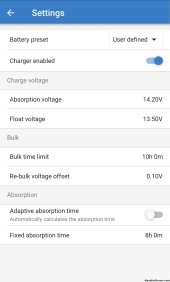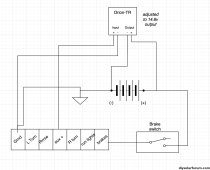sbsyncro
New Member
I've searched and read a lot of posts and all discuss one of two scenarios: (1) charging directly from the 7-pin without a dC-DC controller or (2) running a heavy gauge wire pair from the tow vehicle to a dedicated high-amp connector on the trailer and using a high amperage DC-DC smart charger. I'm considering a simpler "hybrid" solution that seems to provide some benefit but eliminates the need for running that dedicated circuit & connector (and uses a much less expensive DC-Dc charger) but didn't find any previous posts that address my remaining question.
AOLithium 100 ah LiFePO battery mounted in my trailer will be charged in three possible ways:
1. Shore power: NOCO Genius 10x1 AC-DC charger with Lithium profile
2. Solar: Victron MPPT solar controller (also with Lithium profile)
3. Underway: Victron Orion TR 12/12 110w DC-DC charger with fixed voltage output that can be adjusted 10v-15v via pot.
Scenario #3 will use the existing 7-pin connector, which is rated to 15 amps according to the vehicle manual. The Orion unit simply acts as a voltage booster/regulator and is limited to 9 amps (110w). It will not be relied upon for restoring a deeply-discharged battery, but rather as a "top off/trickle charger" while transiting between camps.
QUESTION:
What voltage should I set the DC-DC charger’s output?
I assume it should be somewhere between 13.2v and 14.6v. This will be used during (potentially long) drives when the battery might already full, but most likely slightly discharged from light overnight use. Generally speaking, should the BMS cut off charging input when that is the case? if Max charge voltage on the LiFePO battery is 14.6v can one safely supply that voltage continuously, even if the battery is fully charged? (I have reached out to the battery MFR with the same question, and am waiting for their response).
Thanks in advance!
AOLithium 100 ah LiFePO battery mounted in my trailer will be charged in three possible ways:
1. Shore power: NOCO Genius 10x1 AC-DC charger with Lithium profile
2. Solar: Victron MPPT solar controller (also with Lithium profile)
3. Underway: Victron Orion TR 12/12 110w DC-DC charger with fixed voltage output that can be adjusted 10v-15v via pot.
Scenario #3 will use the existing 7-pin connector, which is rated to 15 amps according to the vehicle manual. The Orion unit simply acts as a voltage booster/regulator and is limited to 9 amps (110w). It will not be relied upon for restoring a deeply-discharged battery, but rather as a "top off/trickle charger" while transiting between camps.
QUESTION:
What voltage should I set the DC-DC charger’s output?
I assume it should be somewhere between 13.2v and 14.6v. This will be used during (potentially long) drives when the battery might already full, but most likely slightly discharged from light overnight use. Generally speaking, should the BMS cut off charging input when that is the case? if Max charge voltage on the LiFePO battery is 14.6v can one safely supply that voltage continuously, even if the battery is fully charged? (I have reached out to the battery MFR with the same question, and am waiting for their response).
Thanks in advance!







